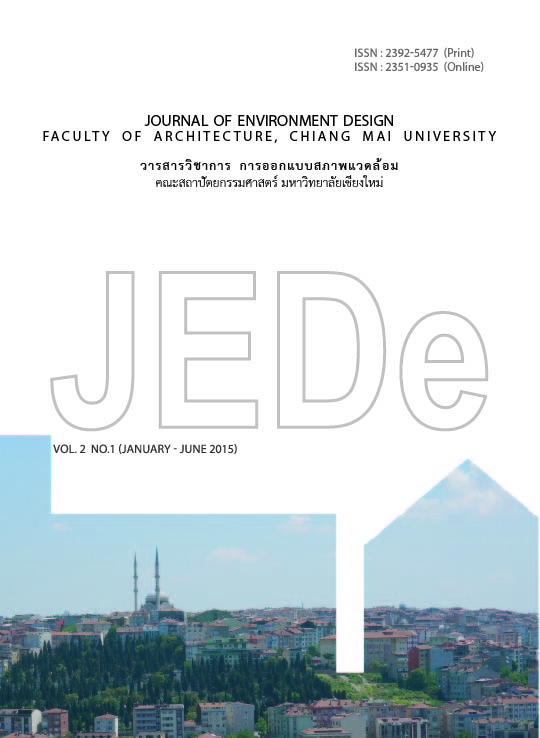รูปแบบและการก่อรูปของสถาปัตยกรรมพื้นถิ่น กะเหรี่ยงปกาเกอญอในพื้นที่พักพิงชั่วคราวบ้าน แม่หละ อำเภอท่าสองยาง จังหวัดตาก (Patterns and Formation of Vernacular Architecture of Karen Refugees in Maela Refugee Camp, Tha Song Yang District, Tak Province)
Main Article Content
บทคัดย่อ
บทความนี้ศึกษาพลวัตทางสถาปัตยกรรมพื้นถิ่นของกะเหรี่ยงปกาเกอญอในพื้นที่พักพิงชั่วคราวที่สะท้อนถึงการเปลี่ยนแปลงพลวัตทางสังคม วัฒนธรรม และการเมืองของกลุ่มชาติพันธุ์ในเอเชียตะวันออกเฉียงใต้ วัตถุประสงค์งานวิจัยเพื่อค้นหารูปแบบเรือนและการก่อรูปของเรือนพื้นถิ่นผู้ลี้ภัยกะเหรี่ยงปกาเกอญอ ในพื้นที่พักพิงชั่วคราวแม่หละ อำเภอท่าสองยาง จังหวัดตาก ในพื้นที่ C1/BB และ C1/A เป็นงานวิจัยเชิงคุณภาพ ใช้วิธีสังเกตอย่างมีส่วนร่วมในการเก็บข้อมูล โดยการสำรวจเรือน ร่างภาพ จดบันทึก สัมภาษณ์เจ้าของเรือน หรือผู้นำชุมชน และนักวิชาการในพื้นที่พักพิงชั่วคราว ผลวิจัยพบว่ารูปแบบเรือนแบ่งออกเป็น 2 กลุ่ม ได้แก่ 1) กลุ่มเรือนพักพิงแบบดั้งเดิมประกอบด้วย เรือนพักพิงแบบดั้งเดิมของครอบครัวเล็ก และ เรือนพักพิงแบบ ดั้งเดิมของครอบครัวใหญ่ 2) กลุ่มเรือนที่มีการปรับเปลี่ยน ประกอบด้วย เรือนพักพิงที่มีปรับเปลี่ยนในพื้นที่ จำกัด เรือนพักพิงที่มีการปรับเปลี่ยนมีพื้นที่ทำกิน และเรือนพักพิงที่มีการปรับเปลี่ยนรูปแบบพิเศษ การก่อรูปของสถาปัตยกรรมพื้นถิ่นในพื้นที่พักพิงชั่วคราวเกิดขึ้นภายใต้ 2 ปัจจัยหลักได้แก่ ปัจจัยทางสังคม และ ปัจจัยทางกายภาพ ผู้วิจัยยังพบรูปแบบเรือนที่ค้นพบมีความเชื่อมโยงกับปัจจัยการก่อรูปของสถาปัตยกรรมพื้นถิ่นในพื้นที่พักพิงชั่วคราว งานวิจัยนี้สะท้อนให้เห็นพลวัตสถาปัตยกรรมพื้นถิ่นที่มีความหลากหลาย ทำให้ ตระหนักถึงความสำคัญของภูมิปัญญาชาติพันธุ์การอยู่ร่วมกับสภาพแวดล้อม การเมือง สังคมวัฒนธรรมที่ เปลี่ยนไปในภูมิภาคเอเชียตะวันออกเฉียงใต้
This paper explores the dynamic in vernacular architecture of Pwa Ka Nkaw Karen ethnic group in refugee camp in relation to the dynamic in social, culture and politic of ethnic group in Southeast Asia. The objectives of this research are to investigate the pattern and formation of Pwa Ka Nkaw Karen’s vernacular architecture in Mae La refugee camp, Tha Song Yang distric, Tak province. This method base on a qualitative research using participant observation to collect the data including architectural surveys and interviews with house owners, community leaders, local administrators and experts. The research area is in Zone c1/a and Zone c1/BB. The finding showed that the pattern of Pwa Ka Nkaw Karen’s house can be divided into 2 groups : 1) original house can be divided into 2 patterns include small family house and large family house 2) extended family house can be divided in to 3 patterns include extended family house with limited space, extended family house with cultivating area and special extended family house. The formation of vernacular architecture in Maela refugee camp is under 2 factors including social factor and physical factor. The finding also showed that the patterns of Paw Ka Nkaw Karen’s house are related to the both factors of the formation. This research reflects diverse way of dynamic of vernacular in controlled conditions and environment that plays part in the change of ethnic communities in Southeast Asia.


